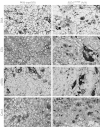Endoplasmic reticulum stress disrupts placental morphogenesis: implications for human intrauterine growth restriction
- PMID: 22733590
- PMCID: PMC3532660
- DOI: 10.1002/path.4068
Endoplasmic reticulum stress disrupts placental morphogenesis: implications for human intrauterine growth restriction
Abstract
We recently reported the first evidence of placental endoplasmic reticulum (ER) stress in the pathophysiology of human intrauterine growth restriction. Here, we used a mouse model to investigate potential underlying mechanisms. Eif2s1(tm1RjK) mice, in which Ser51 of eukaryotic initiation factor 2 subunit alpha (eIF2α) is mutated, display a 30% increase in basal translation. In Eif2s1(tm1RjK) placentas, we observed increased ER stress and anomalous accumulation of glycoproteins in the endocrine junctional zone (Jz), but not in the labyrinthine zone where physiological exchange occurs. Placental and fetal weights were reduced by 15% (97 mg to 82 mg, p < 0.001) and 20% (1009 mg to 798 mg, p < 0.001), respectively. To investigate whether ER stress affects bioactivity of secreted proteins, mouse embryonic fibroblasts (MEFs) were derived from Eif2s1(tm1RjK) mutants. These MEFs exhibited ER stress, grew 50% slower, and showed reduced Akt-mTOR signalling compared to wild-type cells. Conditioned medium (CM) derived from Eif2s1(tm1RjK) MEFs failed to maintain trophoblast stem cells in a progenitor state, but the effect could be rescued by exogenous application of FGF4 and heparin. In addition, ER stress promoted accumulation of pro-Igf2 with altered glycosylation in the CM without affecting cellular levels, indicating that the protein failed to be processed after release. Igf2 is the major growth factor for placental development; indeed, activity in the Pdk1-Akt-mTOR pathways was decreased in Eif2s1(tm1RjK) placentas, indicating loss of Igf2 signalling. Furthermore, we observed premature differentiation of trophoblast progenitors at E9.5 in mutant placentas, consistent with the in vitro results and with the disproportionate development of the labyrinth and Jz seen in placentas at E18.5. Similar disproportion has been reported in the Igf2-null mouse. These results demonstrate that ER stress adversely affects placental development, and that modulation of post-translational processing, and hence bioactivity, of secreted growth factors contributes to this effect. Placental dysmorphogenesis potentially affects fetal growth through reduced exchange capacity.
Keywords: Akt; Igf2; Pdk1; endoplasmic reticulum; intrauterine growth restriction; mTOR; placental morphogenesis; stress.
Copyright © 2012 Pathological Society of Great Britain and Ireland. Published by John Wiley & Sons, Ltd.
Figures







References
-
- Hafner E, Metzenbauer M, Hofinger D, et al. Placental growth from the first to the second trimester of pregnancy in SGA-foetuses and pre-eclamptic pregnancies compared to normal foetuses. Placenta. 2003;24:336–342. - PubMed
-
- Thame M, Osmond C, Bennett F, et al. Fetal growth is directly related to maternal anthropometry and placental volume. Eur J Clin Nutr. 2004;58:894–900. - PubMed
-
- Constancia M, Hemberger M, Hughes J, et al. Placental-specific IGF-II is a major modulator of placental and fetal growth. Nature. 2002;417:945–948. - PubMed
-
- Benton SJ, Hu Y, Xie F, et al. Can placental growth factor in maternal circulation identify fetuses with placental intrauterine growth restriction? Am J Obstet Gynecol. 2012;206:163.e1–7. - PubMed
Publication types
MeSH terms
Substances
Grants and funding
LinkOut - more resources
Full Text Sources
Other Literature Sources
Molecular Biology Databases
Miscellaneous

